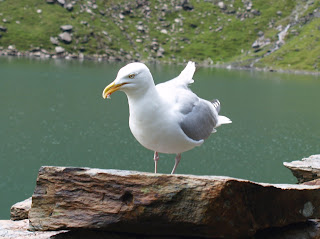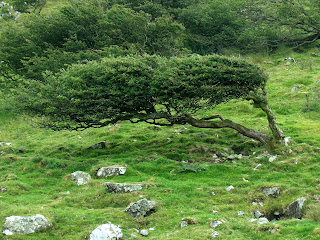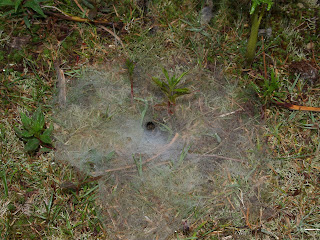This is an account of a short birdwatching trip to Central Poland at the end of May 2007. The area visited is about 100km West of Warsaw
(Warszawa), and 30km South of the nearest town, Włocławek (pronounced: vwots-warvek).
The landscape is a mixture of farmland (mainly Rye, Maize and Potatoes) and woodland (conifers and mixed). The farmland fields are generally in narrow strips with grassy borders. Many cornflowers, daisies and poppies grow at the edges of the fields and within the crops.


The house was adjacent to the village school and within the school grounds. Birds seen here were Golden Oriole
(wilga), Black Redstart
(kopciuszek), Red-Backed Shrike
(gąsiorek), House Sparrow
(wróbel) and Fieldfare
(kwiczoł).
A fieldfare
(kwiczoł) had a nest in an apple tree and the black redstarts
(kopciuszek) were nesting in an old out-building. Nightingales
(słowik rdzawy) could be heard from the garden. A short walk away, a pair of White Storks (
Bocian Biały) were nesting on a platform close to some farm buildings.
Details of a day’s walk:On leaving the school-yard the lane was a sandy track, passed a few houses and then between fields. On the track in front were a couple of Blue-Headed Wagtails
(pliszka żółta). Dozens of Skylarks
(skowronek) were signing from or above the Rye fields.
A single Corn Bunting
(potrzeszcz) was signing from a small bush and a White Wagtail
(pliszka siwa) was also seen.

A Corn bunting was seen here
As I approached the woods a Black Kite
(kania czarna) and a Common Buzzard
(myszołów) were seen over the treetops. There is a rubbish dump within the woods, it’s possible that the Kite had been feeding there.
In the first conifer woods Golden Orioles
(wilga), Hawfinches
(grubodziόb zwyczajny) and Nuthatches
(kowalik) were seen. On the downside the place was swarming with mosquitoes. I wished that I had brought some Jungle Formula. I’ve never been bitten so much in all my life. The weather was hot and I was wearing shorts. Jumping around slapping my legs like an Austrian lederhosen-wearing yodeller was ideal for birdwatching, so I decided to keep to the edges of woods as much as possible. Here the mosquitoes were not so bad.
Coming out of the woods the I reached a sandy path which was bordered by farmland a few farm houses, more woodland and recently felled woodland. Here a nightingale
(słowik rdzawy) was heard signing (it was still quite early on the day).
Along the track was a woodlark
(kalandra szara) at the edge of a recently felled woodland. Here there was also a Great Spotted Woodpecker
(dzięcioł duży). All along the track there were Red-Backed Shrikes
(gąsiorek), a very common bird in this area.
After a short walk along the track I ventured into a small area of deciduous woodland where I saw a pair of Willow Tits
(czarnogłówka) and a male Redstart
(pleszka). On the other side of the track in some long grass I disturbed a grass snake, which quickly slid off into cover.
Over the woodland all around Common Buzzards (
myszołów) were regularly seen.
The track then opened out into a clear area with farmland on both sides. The fields here were uncultivated. Several hirundines were flying around, Swallows
(dymówka), House Martins
(oknówka) and Sand Martins
(brzegówka) were noted as well as Swifts.
On a telegraph wire there was a Tawny Pipit
(świergotek polny). A Turtle Dove
(turkawka) flew along the track.
2 White Storks
(bocian biały) flew over and landed in a nearby field.
I then arrived at a farmhouse with a small pond opposite. In the reeds around the pond were a couple of Reed Warblers
(trzcinniczek). I was alerted by an alarm call and witnessed a female Blackcap
(kapturka) being chased by a Red-Backed Shrike
(gąsiorek). The blackcap
(kapturka) got away. In the trees around the pond were some Tree Sparrows
(mazurek).
Just beyond the house was a woodland of Birch trees. Here a Tree Pipit
(świergotek drzewny) was singing, and a Wood Warbler
(świstunka leśna) was also seen.
.JPG)
Tree Pipit
Further on the track passed through coniferous woods again. A spotted flycatcher
(muchołówka szara) was flying to and from its perch catching flies.
I took a path through the woods on the right-hand side of the track. The trees were not too dense and a few deciduous trees were also growing in amongst the conifers. A Greenish Warbler was feeding amongst the leaves and another male Redstart
(pleszka) was seen. A buzzard
(myszołów) flew silently through the conifers.
When the path came to an intersection, I noticed the buzzard
(myszołów) sitting on a nest in the tree tops. When it flew off I could see at least 2 fairly large chicks. I later saw a Buzzard
(myszołów) heading towards this nest carrying some food (a small rodent).
The right hand branch of the intersection soon led out to the edge of the wood. Here in the middle of a large grassy field there was a cluster of trees. A Great Grey Shrike
(srokosz) was seen perched on some dead branches.
I returned back in to the wood and took the left-hand branch. This soon opened out into a small clearing. Along the edge a Tree Pipit
(świergotek polny) was seen repeatedly doing its display flight, signing as it flies up into the air to return to the same perch.
Above the woods a Buzzard
(myszołów) was flying over. This was then mobbed by a Goshawk
(jastrząb).
I retraced my steps back to the main track and sat on the verge opposite a clearing to half some lunch (Kiełbasa sandwiches and Czarlotka). Whilst having lunch I noticed 2 Honey Buzzards
(trzmielojad) over the woods in front.
I had almost finished lunch when 2 Hoopoes
(Dudek) flew out of the woods behind me and across to the other side of the clearing. I quickly put the remains of my lunch away and set off in pursuit. I caught up with the Hoopoes
(Dudek) and got some very good views before they continued flying off through the wood.
2 White Storks
(bocian biały) flew over. On some bushes in the clearing was an Ortolan Bunting
(Ortolan).
I walked around the edge of the wood until another track was reached. Here I saw another Goshawk
(jastrząb) over the tops of the trees. Beyond the wood was a large uncultivated area, here Meadow Pipits
(świergotek łąkowy) were seen.
As I made my way back round to the end of the track, where it became a tarmac road there was a male Hen Harrier
(błotniak zbożowy) gliding over a field of rye.
Where the tarmac road re-joined the track there was a female Pied Flycatcher
(muchołówka żałobna) in the hedgerow and yet another Red-Backed Shrike
(gąsiorek).
On the way back, passing the farmhouse (with the pond opposite) a Hobby
(kobuz) flew past. Just beyond this a pair of Golden Orioles
(wilga) flew across the track into the trees at the side. Several more Buzzards
(myszołów) and Red-Backed Shrikes
(gąsiorek) were seen.
At the end of the track, just beyond the first coniferous woodland there was a small lake. Unfortunately there were no birds to be seen here, however as I left a Hooded Crow
(wrona siwa) flew over.

The small lake















.JPG)
.JPG)


.JPG)
.JPG)

.JPG)

.JPG)
.JPG)


.JPG)
.JPG)

.JPG)

.JPG)




.JPG)

.JPG)









.JPG)


